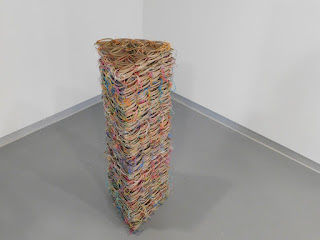At the Crossroads of Leaving and Cleaving
 |
| Ananias J. Dixon (left) and Jeff Haffner |
 |
| Stephanie Cargill (left) and Anne McEvoy |
 |
| Scott Esposito (left) and Stuart Hoffman |
By Tom Wachunas
“How do we leave well and how do we cleave
well?...It’s about what we owe the ones we love – and what we owe
ourselves…about finding the balance between caring for others and allowing
ourselves to be cared for…” - from
the Director’s Note by Craig Joseph
First, here’s a
little background on Canton-based Seat of the Pants Productions. It’s an
itinerant band of theatrical storytellers established by Artistic Director
Craig Joseph in 2012, with a mission to “…focus all our resources on telling
tales, truthfully and beautifully; share compelling narratives in unique spaces
and vibrant communities; develop an aesthetic rooted in imaginative staging and
human connection.”
That mission has
been very well accomplished in Seat of the Pants’ first venture into Cleveland
city limits with Craig Joseph directing The
End of the Tour, a fascinating tragicomedy by playwright Joel Drake
Johnson. There is something oddly appropriate as well as ironic about
experiencing this play in a church (Pilgrim Congregational Church, in Tremont).
Church – a haven of rest and rescue, a house of solace for troubled souls. And
is it not also a place for…confession? As it is, the play happens not in the
ornate sanctuary, but in the big, bland expanse of an adjacent, windowless
chamber. Life is large and often not pretty.
This is an
arresting tale of restive family members and partners desperately navigating
their woundedness while floundering in the wreckage of their dysfunctional
relationships. Set in Dixon, Illinois (the birthplace of Ronald Reagan), we
meet former chanteuse Mae (Anne McEvoy) as she recuperates in a nursing home
after breaking her ankle; her recently divorced daughter, Jan (Stephanie Cargill), who urges
her estranged, Chicago-based brother, Andrew (Stuart Hoffman), to visit their
severely depressed mother. Andrew bickers with his lover, David (Scott
Esposito), over the usefulness of such a reunion. Elsewhere, Jan’s ex-husband,
Chuck (Ananias J. Dixon) wallows in his kitchen. Fretting obsessively over what
to do exactly about his beloved, dying cat, he seeks comfort and counsel from
his best friend, Tommy (Jeff Haffner).
Johnson’s writing
about the vexing foibles and failures of his characters is remarkable in its
sensitivity and insight – an intricate and sometimes indelicate symmetry of illuminating
wisdom and dark wit. He doesn’t set out to cure them of their ills, but simply
tells their truths. And it’s a marvelously facile ensemble here that brings
those characters to life with unflinching, often startling authenticity.
As Mae, Anne McEvoy is riveting as the
impatient patient; the brooding and unapologetic matriarch given to explosive
fits of anger and insult, or complaining about the theft of her candy and
cigarettes by a wandering Alzheimer’s patient named Norma (Chris White). She
seems unable or unwilling to resolve the long-festering conflicts with her
children, and would much rather sing old standards to over-medicated senior
citizens. Meanwhile, Stephanie Cargill is achingly credible as the dutiful but
exhausted daughter, Jan, wearied and frustrated by the sheer emotional weight
and complexity of her circumstances. In the midst of still processing her
divorce, she’s sorely conflicted by caring for the mother she resents.
Stuart Hoffman is
equally commanding in his intriguing portrait of gay brother Andrew. Returning
to Dixon to finally visit his mother, he carries a heavy load of painful
memories from when he was kicked out of his home after coming out in high
school. He’s a bit uncomfortable in his own skin - nervous and insecure about
publically showing physical affection for his lover. In that role, Scott
Esposito is particularly gentle, and might be arguably the most stable
character of the bunch, even as he sadly strives to understand why Andrew keeps
him literally at arm’s length.
Back where a
listless cat lies in a box on a kitchen table, Ananias J. Dixon, as Chuck, is
terribly insecure, too. His exchanges with the delightfully wry and earthy Jeff
Haffner, as Tommy, are among the play’s most tender and funny, though not
without a moment of tearful rage. Watching Dixon agonize over his cat becomes
all the more heartbreaking when sensing that it’s maybe his veiled way of
finally owning the end his marriage.
At the conclusion
of this tour through intersected lives in flux, there was no formula offered,
no prescription given for the characters to ultimately find cathartic healing
or peace. Call it instead a momentary arrival, a tacit acceptance of life on life’s terms.
Now, back to church, and confession time. Thanks
to the expressive intensity of the ensemble’s performance, I began to view the
characters not as merely fictive elements in a metaphor, but actual people. And who couldn’t love
them? Despite the mess they’d made of their lives, I found myself empathizing with
them, rooting for them, hoping the best for them. Good practice for real life.
That’s the power of truly compelling theatre.
- Photos by Aimee Lambes -
The End of the Tour
/ Remaining performances are Friday, April 5th
at 8 PM, and Saturday, April 6th at 2 PM and 8 PM. All shows are performed at Pilgrim Congregational Church in Tremont,
2592 West 14th Street, Cleveland.
Tickets are $20 and can be purchased at
Additional
information about Seat of the Pants Productions at:






















